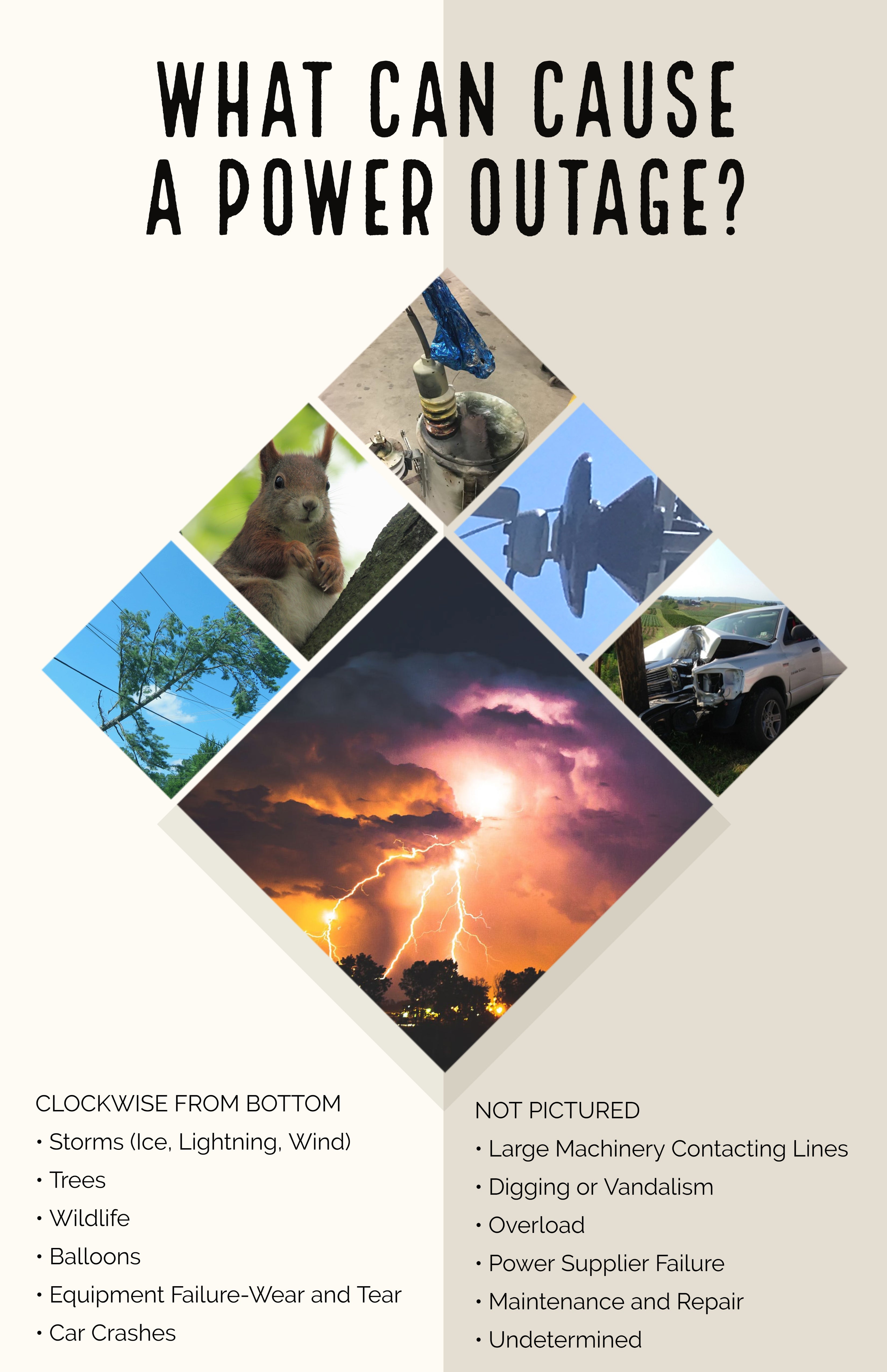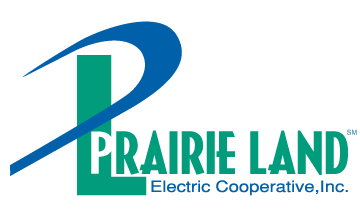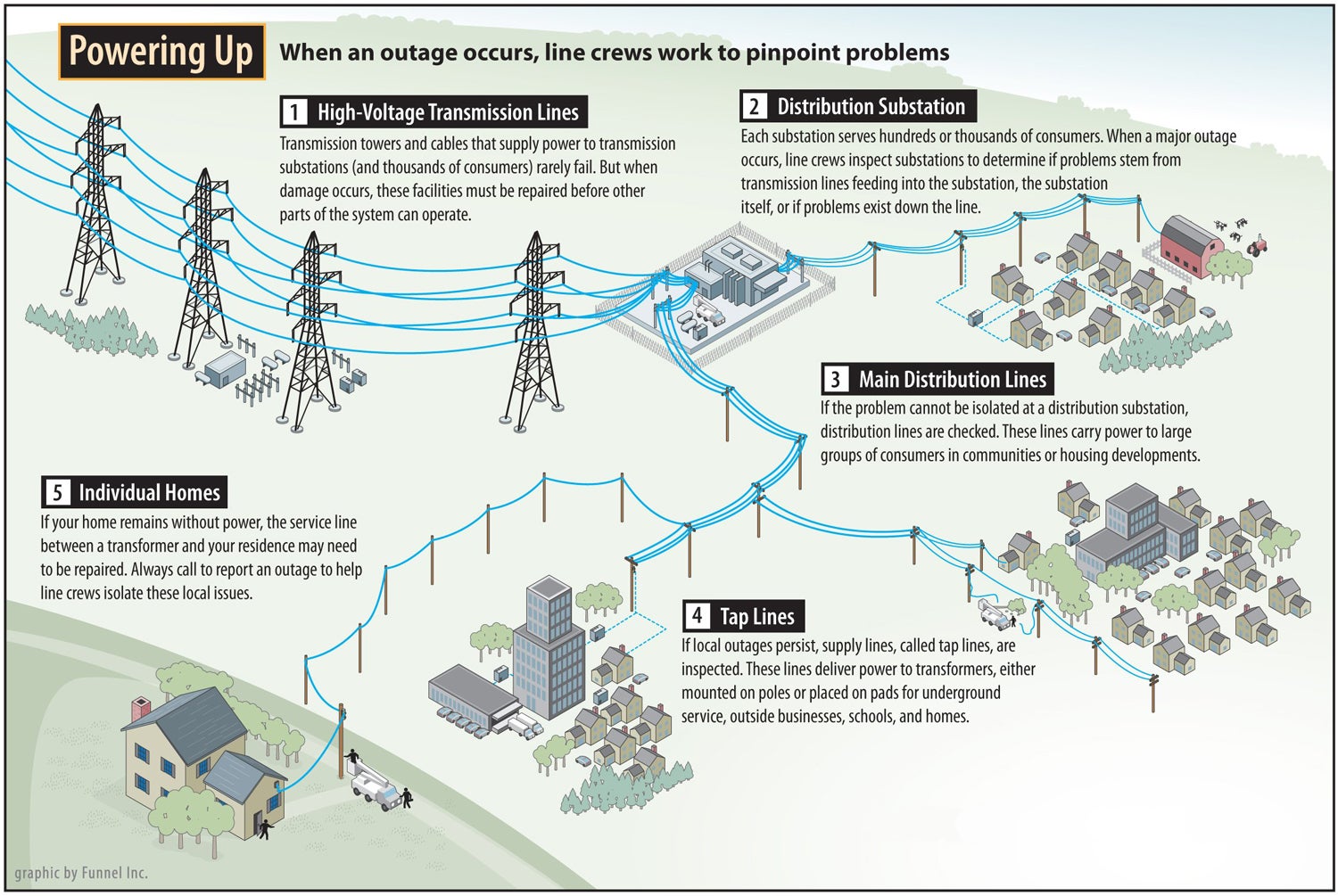Power Outage FAQ
The most significant outages are usually caused by bad weather. Ice and wind can take down lines and the structures that hold them. A lightning strike can damage the equipment needed to transport electricity where it is needed.
Anything that makes contact with the power lines can cause an outage. This includes trees, wildlife, large farm equipment, or even mylar balloons. In the group of images below, the top picture shows a transformer that started on fire from the blue mylar balloon tangled in it.
There are hundreds of complicated components that step the voltage up and down and carry it to our homes and businesses. These components can fail from external damage, or normal wear and tear.
Human behavior or human error can also play a part. Automobile accidents, sabotage/vandalism, switching errors, and digging can take out power.
It's rare in our communities, but an outage can also be caused by overload, when the demand for electricity is higher than can be generated or transmitted.
Also uncommon is a failure by the power supplier. Prairie Land is a distribution cooperative, and our power is purchased from a generation and transmission cooperative. If the power plant goes down or transmission lines are destroyed, power to very large regions will be disrupted.
Every once in a while, the outage is on purpose. Lines will be taken down to accomodate a large load on the highway, or systems will be de-energized to complete maintenance and repairs. Prairie Land makes efforts to notify the affected members if an outage is planned.

Whenever there's an unexpected outage, it's natural to wonder, "Is it just me?" The first thing you might be inclined to do is ask your neighbors if they are also without power.
There's a way to find out, and many members already use it! Just click on the "outage map" button at the top of the page.
Once you click on the "outage map" button, you will see a map of the counties we serve. A dot means there is an outage at that location on the map. A legend in the lower left indicates how many people are included in each color and size of dot. If you notice a dot stays there for a really long time, it's probably been requested to temporarily turn off service to a meter in that area.
It's always best to report your outages by calling 1-800-577-3323.
Our first priority is is to respond to dangerous situations – downed lines or sparking equipment – and then we prioritize efforts to restore power to public health and safety facilities and the greatest number of members as safely and quickly as possible. The amount of time it takes is determined by the location of the problem and the type of problem. If a circuit got closed from a brief contact, power may be back in about the time it takes to drive there. If a big storm has knocked down several poles, that requires a lot more time and manpower. Prairie Land strives to provide ongoing updates on Facebook in the case of a significant outage. Click the outage button at the top of this page to see where the known outages are at any time.
Transmission towers and lines supply power to one or more transmission substations. They carry 115,000 Volts and above. These lines seldom fail, but they can be damaged by high winds or ice. Many thousands of people could be served by one high-voltage transmission line. If a transmission line received damage, it would get attention first.
There are several distribution substations to serve large groups of members. Lines from the sub-transmission substation to the distribution substation carry 34,500 Volts. When a large outage occurs, the local substations are checked first. If a failure is found and repaired, power is restored to almost everyone at once.
Distribution lines from the substation to neighborhoods carry 7200-8000 Volts. These lines are checked next if the problem can't be isolated at the substation. When power is restored at this stage, the entire group of members served by that line are restored at once.
The final supply lines, called service lines, carry 120-240 Volts of power to the meter outside houses or other buildings. Line crews fix the remaining outages based on restoring service to the greatest number of members.
Sometimes damage will occur on the service line between your house and the transformer on the nearby pole. This can explain why you have no power when your neighbor does. Please report the outage so a service crew can repair it. If the outage is caused by a service installation on the building, we can not repair that, and the member needs to use a licensed electrician.
Zebulon Ruda captured some video of galloping lines in Rawlins County on Easter Sunday, April 12, 2020. The strong winds that day caused outages all the way from the Colorado state line to Phillips County.
When high winds and ice combine, it can affect power lines in a unique way that makes them “gallop.”
Ice accumulating on a power line can, first, cause it to sag. As little as a half-inch of ice on a distribution line can make the line drop about a foot. More ice means that the line will sag further.
Add in strong winds and the result is ice that builds up on only one side of a power line. When this disproportionate buildup occurs, it creates an airfoil that changes the flow of air around the line, which can make it start to bounce. This bouncing or galloping can potentially damage the lines, cause power outages and even make the lines fall to the ground.
Once galloping starts, there is not much your electric cooperative can do to alleviate the situation until the winds stop.
There is danger once the lines start bouncing, so stay away. In addition to the possibility of power outages, there is a danger of the lines or other electrical equipment breaking loose and falling or of ice being dislodged from the lines and falling, hitting whatever or whomever is below.
If you see galloping or downed lines, contact Prairie Land as soon as possible at any time day or night by calling 1-800-577-3323.
Electric co-ops occasionally need to replace old or damaged utility poles. This quick video breaks down the process.
Strong, sturdy utility poles are the backbone of a reliable electric system, which is why we routinely inspect them. Throughout the year, our crews check poles for decay caused by exposure to the elements. They know which poles are oldest and conduct inspections through a rotational process. Typically, a standard wooden distribution pole is expected to last more than 50 years. However,weather disasters, power line relocation and car crashes are potential causes for immediate replacement.
Here is a quick breakdown of how crews replace a utility pole:
When a pole needs to be replaced, crews will start the process by digging a hole, typically next to the pole being replaced. The depth of the hole must be 15 percent of the new pole’s height. Next, the new pole must be fitted with bolts, cross arms, insulators, ground wires and arm braces – all of the necessary parts for delivering safe and reliable electricity. Then, crews safely detach the power lines from the old pole. The new pole is then raised and guided carefully into position, and the lines are attached, leaving the new pole to do its job.

